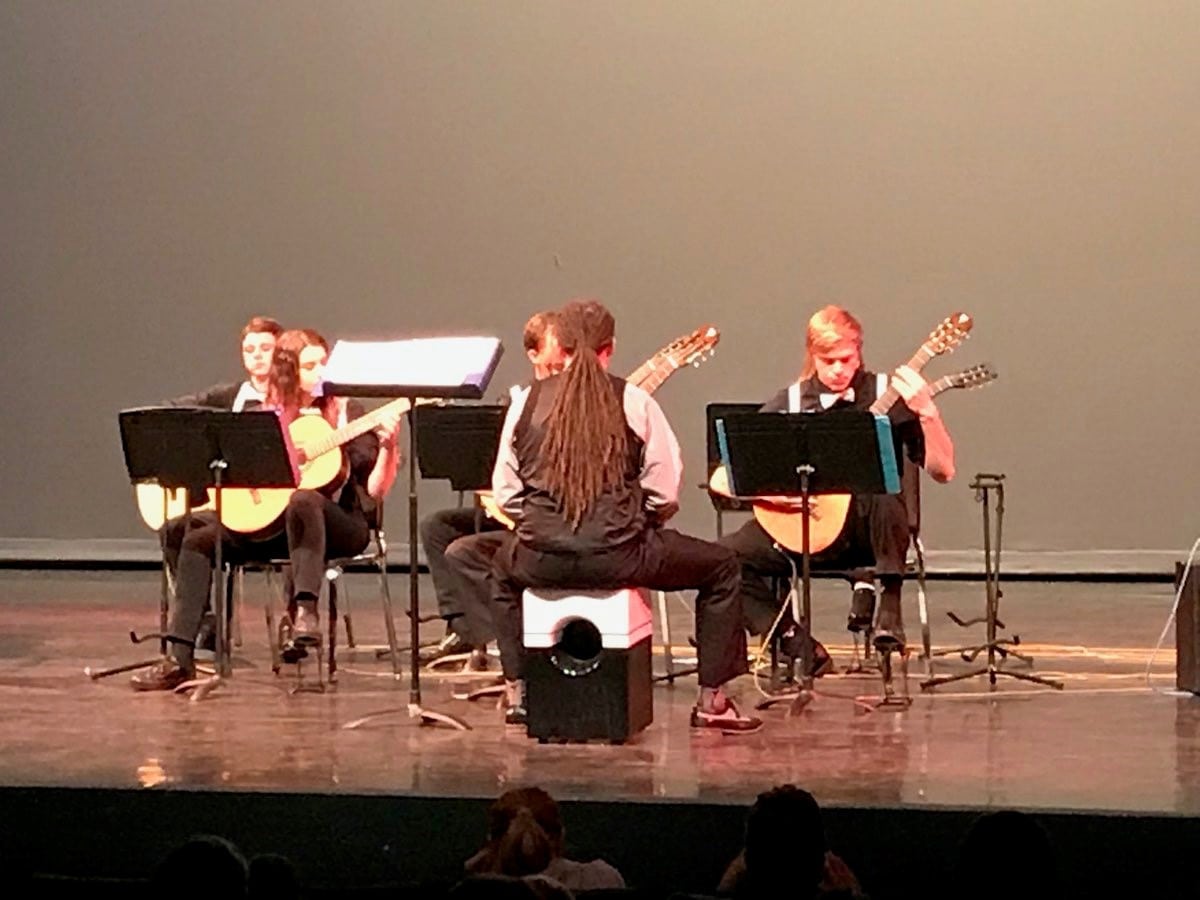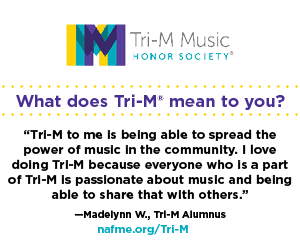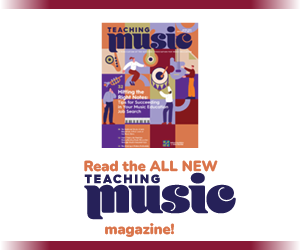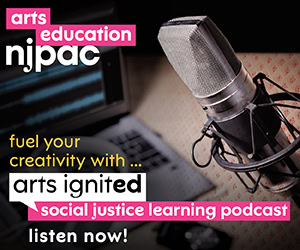/ News Posts / Guitar Class in the Beehive State
Guitar Class in the Beehive State
Number 13: The State of Utah
By Thomas Amoriello Jr.
NAfME Council for Guitar Education Chair
Today we visit David Andersen who started a guitar program at Tuacahn High School for the Performing Arts in Ivins, Utah, which is the first public charter school in his state. A quote from his school webpage sums up his attitude, “I wanted to build a guitar program in Southern Utah. A ‘Performing Arts’ high school was the perfect place to begin. The passion and humor of my students makes every day an adventure here.”
Mr. Andersen holds a Master of Music Performance and Bachelor of Music Education from University of Nevada, Las Vegas. He teaches a music theory course and directs three guitar ensembles at Tuacahn and a beginner guitar ensemble provides an introduction to guitar for those who have never had any previous guitar experience. Intermediate Guitar Ensemble attempts to further the students’ technical and performance level. Titan Classical Guitar is an audition-only ensemble that attempts to further the technical skill of the students and provide them with a variety of style experience.
Thank you, David, for sharing thoughts on guitar education with the NAfME membership.
Please tell us about your school and overall music program at Tuacahn High School Performing Arts.
Tuacahn High School for the Performing Arts is Utah’s first charter school and is celebrating its 20th anniversary this year. The music program has seen different iterations, but for the 2019-2020 school year we will have offerings for Guitar, Orchestra, Piano, House Band, Music Production, Singer/Songwriter, and Sound Engineering.

Photo courtesy of David Andersen
Please tell us about your own personal musical background growing up and your collegiate experience.
I grew up in the small town of Overton, Nevada (approximately 60 miles north of Las Vegas). My parents weren’t musicians but were large consumers of music. There was always music playing in the house—the likes of Bread, The Beatles, Chicago, Beach Boys, etc. My mom tried to get me involved with piano when I was young, but it never stuck.
There wasn’t much to do in the small town, so about 80% of the school population was in band/orchestra/choir. I started in middle school on percussion for concert band and continued on with it to high school where I played in Concert Band, Pep Band, and Jazz Band. I always enjoyed hearing the guitar, but always thought it was a little too complicated for me to play. I finally picked up the guitar when I was 20 years old. I started to teach myself guitar on a 3/4 size guitar my mom had brought back from a cruise to Mexico—just a few popular songs strumming chords.
I first attended University Las Vegas, Nevada (UNLV) as a psychology major, but decided to go more with a subject I loved, music. I began taking classical guitar from Dr. Adam Foster (formerly of the Tantalus Quartet). I was horrible! You hear about the people with natural music ability, and I was not that guy. It took many, many hours of practice just to be a decent beginner at the classical style. Dr. Foster was extremely patient and encouraging. My sophomore year is when I started to see the payoff of all those hours of practice, and I finally began to advance in my studies. I received a double Bachelors in Music Education and Performance. I continued my studies at UNLV under Ricardo Cobo for my MM in Performance.
How do the guitar family of instruments fit into your teaching?
In building this program, I have focused mainly on just guitar. As a pit musician performing for the regional Tuacahn Amphitheater I have had the opportunity to learn Oud, Greek Bouzouki, Mandolin, Banjo—which I am hoping to slowly introduce to students and the connection with guitar.

Photo courtesy of David Andersen
What obstacles did you face when you were first hired at your school? Now?
I volunteered my first year just to get my foot in the door and the beginnings of a guitar program. I helped teach a group of seven students. Fortunately, those students worked hard and demonstrated that this could be a viable program at Tuacahn. The next year I received two classes to teach. The obstacle in the beginning was trying to close the gap in terms ability and technique, so that we could play higher level pieces. The obstacles now are to continue to grow the program and keep students interested in the instrument. We are a small school of about 400 and currently have 75-85 students taking guitar.
What kind of classes related to the guitar do you teach?
I teach Music Theory, History of Rock ‘N’ Roll and Pit Band, Beginning Guitar, Intermediate Guitar, and Guitar Ensemble
What would you like to say to the non-guitarist music educator who is about to or interested in incorporating the guitar into their program?
Don’t be afraid to ask for help from your local guitar teachers. Bring them in to showcase different styles and techniques to demonstrate what the instrument is capable of. Give yourself some time with the instrument before implementing, and take note of what pitfalls you are running into. Chances are your students will hit the same barriers. Attend workshops whenever possible. I garner so many new ideas and items when I attend, and it helps me to become more of a well-rounded educator.
“Give yourself some time with the instrument before implementing, and take note of what pitfalls you are running into. Chances are your students will hit the same barriers.”
Do you have any success stories you would like to share about students (musical and non-musical)?
For my program personally, guitar attracts a different breed of student than those found in orchestra or band. The first years attracted many students for whom “school’s not their thing” (direct student quote). Seeing those students thrive in my class was, and still is, among my greatest victories. You start to see some of the success on guitar begin to trickle to other subjects sometimes. A few of them went and formed bands and became my favorite guitarists to listen to.

Photo courtesy of David Andersen
What do you tell your talented students who are planning to pursue music or guitar studies in high school, college after they finish with you?
Finding the right teacher is key to their success. It was sheer dumb luck that I lived close to UNLV and had the great opportunity to study with the amazing teachers that I did. Their personalities and teaching style were both what I needed at the time I needed it. I encourage them to research their school and the faculty there. Sometimes their perfect fit for a teacher will not be at the most prestigious school. The right teacher can have a profound impact on your career path.
Do you have any networking or advocacy tools that have worked for you promoting your program that would help other educators?
My biggest tool of promotion for the guitar program is our Titan Guitar Ensemble. They are the main performing guitar ensemble performing group at our school. Each year I have been blessed with some great players who have ALWAYS risen to the occasion and put on some fantastic performances. Our big performance is our annual “Sweet Sounds Guitar Soiree,” where we put on a 90- to 120-minute concert while serving various deserts and hors d’oeuvres. It has grown from a small affair to a packed house the past few years.
We are also now beginning to collaborate with a few of the other schools in the state and putting on joint concerts for our communities. My hope is to make this an annual thing as well, and possibly a step into forming an All-State Guitar ensemble in the future.
What kind of future do you see for guitar in music education in the Utah school system?
I see one that is growing. More and more schools are teaching guitar in the state. Due to this, more guitar ensembles are forming, and it has been a delight to see some of them grow. My hope is that we can begin to develop the guitar curriculum for the state beyond the 1- to 2-year programs that most have now. With the inclusion of the guitar in the NAfME All-National Honor Ensembles, it is showcasing that guitar is becoming a viable program in the nation and will hopefully open up more avenues for our programs to grow here in Utah.
Do you do any musical performance or activities outside of your public school teaching duties?
I work as a pit musician during the summertime when they are in need of a guitarist. I am also working on a classical duo with my fellow UNLV graduate Patrick Worley. This year I will be working toward preparing a solo set sampling an array of different genres and techniques that the guitar uses, as well as incorporating other string instruments I have learned along the way.
Any last thoughts to conclude our interview?
In the words of the illustrious Bill and Ted: “Be Excellent to Each Other!”
Past “Guitar Class in 50 States” articles:
- Number 50: The Granite State (New Hampshire)
- Number 49: The Green Mountain State (Vermont)
- Number 48: The Mountain State (West Virginia)
- Number 47: The Hoosier State (Indiana)
- Number 46: The Mount Rushmore State (South Dakota)
- Number 45: The Pine Tree State (Maine)
- Number 44: The Badger State (Wisconsin)
- Number 43: The Constitution State (Connecticut)
- Number 42: The Evergreen State (Washington)
- Number 41: The Pelican State (Louisiana)
- Number 40: The Beaver State (Oregon)
- Number 39: The Equality State (Wyoming)
- Number 38: The Empire State (New York)
- Number 37: The Old Line State (Maryland)
- Number 36: The Centennial State (Colorado)
- Number 35: The Bay State (Massachusetts)
- Number 34: The Sooner State (Oklahoma)
- Number 33: The Prairie State (Illinois)
- Number 32: The Hawkeye State (Iowa)
- Number 31: The Volunteer State (Tennessee)
- Number 30: The Palmetto State (South Carolina)
- Number 29: The Natural State (Arkansas)
- Number 28: The Tar Heel State (North Carolina)
- Number 27: The Magnolia State (Mississippi)
- Number 26: The Peace Garden State (North Dakota)
- Number 25: The Treasure State (Montana)
- Number 24: The First State (Delaware)
- Number 23: The Buckeye State (Ohio)
- Number 22: The Yellowhammer State (Alabama)
- Number 21: The Sunflower State (Kansas)
- Number 20: The Great Lakes State (Michigan)
- Number 19: The Lone Star State (Texas)
- Number 18: The Bluegrass State (Kentucky)
- Number 17: The Golden State (California)
- Number 16: The Show-Me State (Missouri)
- Number 15: The Keystone State (Pennsylvania)
- Number 14: The Last Frontier State (Alaska)
- Number 12: The Peach State (Georgia)
- Number 11: The Cornhusker State (Nebraska)
- Number 10: The Gem State (Idaho)
- Number 9: The Old Dominion (Virginia)
- Number 8: The Aloha State (Hawaii)
- Number 7: The Land of Enchantment (New Mexico)
- Number 6: The Sunshine State (Florida)
- Number 5: The Grand Canyon State (Arizona)
- Number 4: The Ocean State (Rhode Island)
- Number 3: The North Star State (Minnesota)
- Number 2: The Silver State (Nevada)
- Number 1: The Garden State (New Jersey)
About the author:
 Thomas Amoriello Jr. serves as the chair on the NAfME Council for Guitar Education and is also the Chairperson for the New Jersey Music Education Association. Tom has taught guitar classes for the Flemington Raritan School District in Flemington, New Jersey, since 2005 and was also an adjunct guitar instructor at Cumberland County College, New Jersey, for five years. He has earned a Master of Music Degree in Classical Guitar Performance from Shenandoah Conservatory and a Bachelor of Arts in Music from Rowan University. He is the author of the children’s picture books; A Journey to Guitarland with Maestro Armadillo and Ukulele Sam Strums in the Sand), both available from Black Rose Writing. He recently made a heavy metal recording with a stellar roster of musicians including former members of Black Sabbath, Whitesnake, Ozzy Osbourne, Yngwie J. Malmsteen’s Rising Force, and Dio that was released on H42 Records of Hamburg, Germany. The record released on 12-inch vinyl and digital platforms has received favorable reviews in many European rock magazines and appeared on the 2018 Top 15 Metal Albums list by Los Angeles KNAC Radio (Contributor Dr. Metal). Visit thomasamoriello.com for more information.
Thomas Amoriello Jr. serves as the chair on the NAfME Council for Guitar Education and is also the Chairperson for the New Jersey Music Education Association. Tom has taught guitar classes for the Flemington Raritan School District in Flemington, New Jersey, since 2005 and was also an adjunct guitar instructor at Cumberland County College, New Jersey, for five years. He has earned a Master of Music Degree in Classical Guitar Performance from Shenandoah Conservatory and a Bachelor of Arts in Music from Rowan University. He is the author of the children’s picture books; A Journey to Guitarland with Maestro Armadillo and Ukulele Sam Strums in the Sand), both available from Black Rose Writing. He recently made a heavy metal recording with a stellar roster of musicians including former members of Black Sabbath, Whitesnake, Ozzy Osbourne, Yngwie J. Malmsteen’s Rising Force, and Dio that was released on H42 Records of Hamburg, Germany. The record released on 12-inch vinyl and digital platforms has received favorable reviews in many European rock magazines and appeared on the 2018 Top 15 Metal Albums list by Los Angeles KNAC Radio (Contributor Dr. Metal). Visit thomasamoriello.com for more information.
Did this blog spur new ideas for your music program? Share them on Amplify! Interested in reprinting this article? Please review the reprint guidelines.
The National Association for Music Education (NAfME) provides a number of forums for the sharing of information and opinion, including blogs and postings on our website, articles and columns in our magazines and journals, and postings to our Amplify member portal. Unless specifically noted, the views expressed in these media do not necessarily represent the policy or views of the Association, its officers, or its employees.
Catherina Hurlburt, Marketing Communications Manager. April 4, 2019. © National Association for Music Education (NAfME.org)
Published Date
April 4, 2019
Category
- Ensembles
Copyright
April 4, 2019. © National Association for Music Education (NAfME.org)






